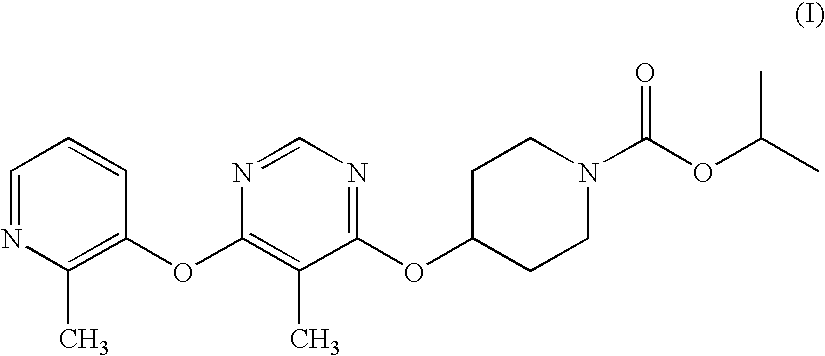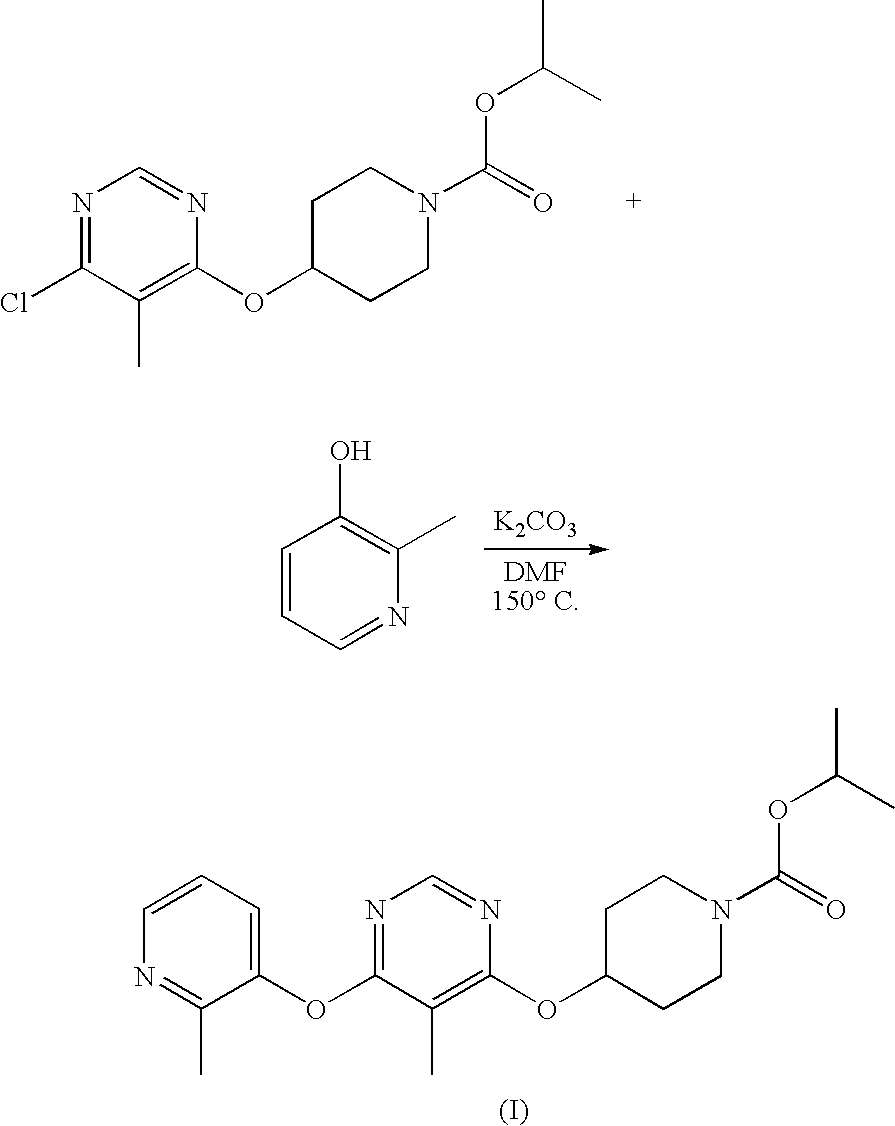Modulators of Metabolism and the Treatment of Disorders Related Thereto
a technology of metabolism and modulators, applied in the field of 45methyl6(2methylpyridin3yloxy)pyrimidin4yloxypiperidine1carboxylic acid isopropyl ester, can solve the problems of elevated blood glucose levels, serious health problems, and inability to move glucose into the cells of the individual, so as to reduce the weight gain of the individual
- Summary
- Abstract
- Description
- Claims
- Application Information
AI Technical Summary
Benefits of technology
Problems solved by technology
Method used
Image
Examples
example 1
In Vivo Effects of a RUP3 Agonist on Glucose Homeostasis in Rats
[0127]General Procedure—Oral Glucose Tolerance Test (oGTT)
[0128]Male Sprague Dawley rats (Harlan, San Diego, Calif.) weighing approximately 350-375 g were fasted for 16 hours and randomly grouped (n=6) to receive a RUP3 agonist at 0.3, 3 or 30 mg / kg. Compounds were delivered orally via a gavage needle (p.o., volume 2 mL / kg). At time 0, levels of blood glucose were assessed using a glucometer (Accu-Chek Advantage, Roche Diagnostics), and rats were administered either vehicle (20% hydroxypropyl-beta-cyclodextrin) or test compound. Thirty minutes after administration of test compound, levels of blood glucose were again assessed, and rats were administered dextrose orally at a dose of 3 g / kg. Blood glucose measurements were then taken 30 min, 60 min, and 120 min after this time. Table 1 shows the mean percentage inhibition of glucose excursion for each test compound, averaged across the six animals in the treatment group. T...
example 2
[0129]In addition to the methods described herein, another means for evaluating a test compound is by determining binding affinities to the RUP3 receptor. This type of assay generally requires a radiolabelled ligand to the RUP3 receptor. Absent the use of known ligands for the RUP3 receptor and radiolabels thereof, compounds of Formula (I) can be labelled with a radioisotope and used in an assay for evaluating the affinity of a test compound to the RUP3 receptor.
[0130]A radiolabelled RUP3 compound of Formula (I) can be used in a screening assay to identify / evaluate compounds. In general terms, a newly synthesized or identified compound (i.e., test compound) can be evaluated for its ability to reduce binding of the “radiolabelled compound of Formula (I)” to the RUP3 receptor. Accordingly, the ability to compete with the “radio-labelled compound of Formula (I)” or Radiolabelled RUP3 Ligand for the binding to the RUP3 receptor directly correlates to its binding af...
example 3
CYP Procedure
[0139]The P450 inhibition screening assay was performed in 96-well microtiter plates by using cDNA expressed human enzymes (CYP1A2, 2C9, 2C19, 2D6 and 3A4). The test compounds (prepared in acetonitrile) were serially diluted in phosphate buffer (pH 7.4) containing an electron generating system (glucose-6-phosphate, NADP+ and glucose-6-phosphate dehydrogenase). The enzymatic reaction was initiated by adding individual P450 enzymes pre-mixed with P450-specific fluorescent substrates, and stopped by adding acetonitrile (or NaOH for DBF assays) to the reaction mixture after incubation at 37° C. for a given amount of time. The fluorescence of metabolites was measured on a Biotek fluorescence reader. The results were expressed as inhibition percentage relative to the control (no test compound). IC50 values were estimated from the concentration response curve. The P450 substrates used for the assay include dibenzylfluorescein (DBF, for CYP2C9, 2C19 and 3A4), 3-cyano-7-ethoxyco...
PUM
| Property | Measurement | Unit |
|---|---|---|
| particle size | aaaaa | aaaaa |
| time | aaaaa | aaaaa |
| time | aaaaa | aaaaa |
Abstract
Description
Claims
Application Information
 Login to View More
Login to View More - R&D
- Intellectual Property
- Life Sciences
- Materials
- Tech Scout
- Unparalleled Data Quality
- Higher Quality Content
- 60% Fewer Hallucinations
Browse by: Latest US Patents, China's latest patents, Technical Efficacy Thesaurus, Application Domain, Technology Topic, Popular Technical Reports.
© 2025 PatSnap. All rights reserved.Legal|Privacy policy|Modern Slavery Act Transparency Statement|Sitemap|About US| Contact US: help@patsnap.com



